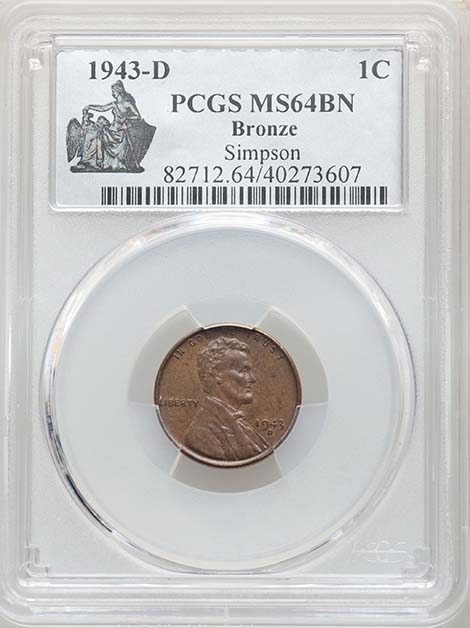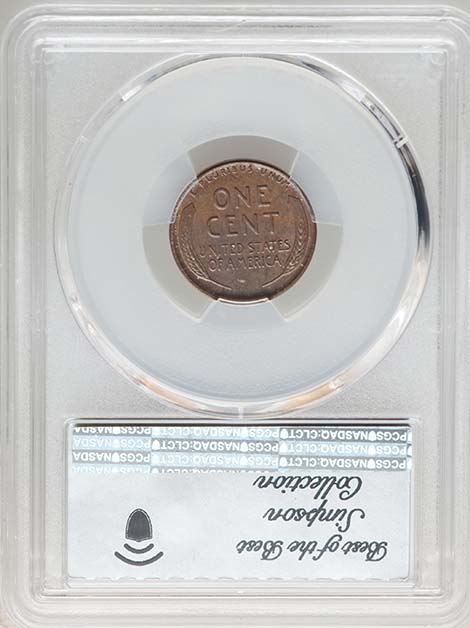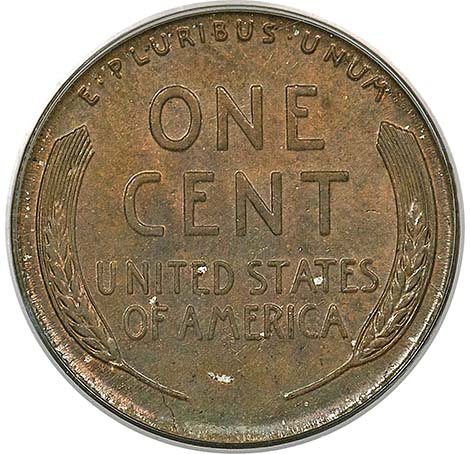Featured in the upcoming January 2021 FUN US Coins Signature Auction #1326
1943-D 1C Struck on a Bronze Planchet MS64 Brown PCGS. Ex: Simpson.
 The 1943-D bronze Lincoln cent is a legendary rarity, with just a single example known to collectors. This sought-after wrong planchet error is the Holy Grail of error collectors, but its appeal extends far beyond traditional numismatics. Like its slightly more available Philadelphia and San Francisco Mint counterparts, the 1943-D bronze Lincoln cent has an "everyman" appeal that is missing with most numismatic rarities. Generations of school children have thrilled to colorful ads in comic books promising a fortune to anyone lucky enough to find a 1943 "copper" cent in change. Their parents have pondered more sophisticated advertisements in mainstream magazines. Many suburban and blue-collar workers marveled at the unfounded mid-20th century rumor that Henry Ford would give a new car to anyone who could provide him with a "copper" 1943 cent, despite the Ford Motor Company's repeated denials. The 1943 bronze cents have been recognized and avidly sought by the general public more than any other great numismatic rarity. Heritage Auctions is privileged to present the finest-known and rarest example of the famous 1943 "copper" cents in just its third auction appearance.
The 1943-D bronze Lincoln cent is a legendary rarity, with just a single example known to collectors. This sought-after wrong planchet error is the Holy Grail of error collectors, but its appeal extends far beyond traditional numismatics. Like its slightly more available Philadelphia and San Francisco Mint counterparts, the 1943-D bronze Lincoln cent has an "everyman" appeal that is missing with most numismatic rarities. Generations of school children have thrilled to colorful ads in comic books promising a fortune to anyone lucky enough to find a 1943 "copper" cent in change. Their parents have pondered more sophisticated advertisements in mainstream magazines. Many suburban and blue-collar workers marveled at the unfounded mid-20th century rumor that Henry Ford would give a new car to anyone who could provide him with a "copper" 1943 cent, despite the Ford Motor Company's repeated denials. The 1943 bronze cents have been recognized and avidly sought by the general public more than any other great numismatic rarity. Heritage Auctions is privileged to present the finest-known and rarest example of the famous 1943 "copper" cents in just its third auction appearance.
Origin of the 1943 "Copper" Cents
 The Second World War was at its height in 1943 and copper was an essential commodity in the wartime economy. It was used by defense contractors in the manufacture of everything from shell casings to commo wire. To conserve this strategic metal for the war effort, the Treasury Department decided to use zinc-coated steel planchets instead of the usual bronze coin blanks to produce all Lincoln cents that year. The resulting "steel" cents were produced in enormous numbers and many examples were saved by collectors for their novelty value. Unfortunately, the coins resembled dimes when new, with their brilliant white surfaces, causing some confusion in everyday transactions. Also, the zinc coating did not wear well and the coins quickly acquired a dull, ugly patina in circulation. The Treasury Department returned to using bronze planchets for cent coinage the following year.
The Second World War was at its height in 1943 and copper was an essential commodity in the wartime economy. It was used by defense contractors in the manufacture of everything from shell casings to commo wire. To conserve this strategic metal for the war effort, the Treasury Department decided to use zinc-coated steel planchets instead of the usual bronze coin blanks to produce all Lincoln cents that year. The resulting "steel" cents were produced in enormous numbers and many examples were saved by collectors for their novelty value. Unfortunately, the coins resembled dimes when new, with their brilliant white surfaces, causing some confusion in everyday transactions. Also, the zinc coating did not wear well and the coins quickly acquired a dull, ugly patina in circulation. The Treasury Department returned to using bronze planchets for cent coinage the following year.
 The 1943 bronze cents were an unintended consequence of switching the planchet composition in 1943. Apparently, a few bronze planchets remained stuck in the tote bins Mint personnel used to feed the coin presses at the end of cent production in 1942. These planchets went unnoticed when the bins were refilled with zinc-coated steel planchets at the beginning of production in 1943. They became dislodged and were fed into the coin presses, along with the "steel" blanks, resulting in the rare wrong-planchet error treasures we know about today. This phenomenon occurred at both the Philadelphia and San Francisco Mints. PCGS CoinFacts estimates 10-15 examples of the Philadelphia Mint issue are extant today, the finest being the MS62 Brown PCGS Simpson example that will be offered in our February 2021 Long Beach Signature. Only six specimens of the San Francisco Mint issue have been confirmed, including the finest-known MS62 Brown PCGS example from the Simpson Collection that we offered in our November 2020 Dallas Signature. The present MS64 Brown PCGS specimen is the only 1943 bronze Lincoln cent struck at the Denver Mint and its story is shrouded in mystery and intrigue.
The 1943 bronze cents were an unintended consequence of switching the planchet composition in 1943. Apparently, a few bronze planchets remained stuck in the tote bins Mint personnel used to feed the coin presses at the end of cent production in 1942. These planchets went unnoticed when the bins were refilled with zinc-coated steel planchets at the beginning of production in 1943. They became dislodged and were fed into the coin presses, along with the "steel" blanks, resulting in the rare wrong-planchet error treasures we know about today. This phenomenon occurred at both the Philadelphia and San Francisco Mints. PCGS CoinFacts estimates 10-15 examples of the Philadelphia Mint issue are extant today, the finest being the MS62 Brown PCGS Simpson example that will be offered in our February 2021 Long Beach Signature. Only six specimens of the San Francisco Mint issue have been confirmed, including the finest-known MS62 Brown PCGS example from the Simpson Collection that we offered in our November 2020 Dallas Signature. The present MS64 Brown PCGS specimen is the only 1943 bronze Lincoln cent struck at the Denver Mint and its story is shrouded in mystery and intrigue.
The Present Coin
 There are two competing accounts of the early history of this coin discussed on PCGS CoinFacts. In his September 20, 2008 column Making Cents, Dr. Sol Taylor reported:
There are two competing accounts of the early history of this coin discussed on PCGS CoinFacts. In his September 20, 2008 column Making Cents, Dr. Sol Taylor reported:
"Finally one specimen of the 1943-D cent is known in bronze. This specimen traces its origins to a deliberately made coin probably by John R. Sinnock, chief engraver of the U.S. Mint at the time - as it was later discovered in the estate of a woman Sinnock was dating in the 1940s, when both lived in the small town of North Tonawanda, N.Y."

This story has been reported in the literature several times over the years, but it seems to have originated as the account prominent coin dealer Harry Foreman related to John Ford about a Philadelphia Mint example of the 1943 bronze cent he sold him in 1961. In the description of the 1943 bronze cent Ford consigned to the William R. Sieck Collection (Bowers and Ruddy, 7/1981), lot 414, the cataloger notes:
"The piece offered herewith is believed to have been the property of John R. Sinnock, former engraver of the Philadelphia Mint. It was obtained from Harry J. Foreman in March 1961. Earlier it was the property of Philadelphia dealer William Grichin, who obtained this piece and the companion 1944 steel cent from a lady friend of John R. Sinnock. She said that this piece was a Christmas present from him to her in 1943."

It seems clear that this account describes the origin of the Philadelphia Mint example in the 1981 auction, rather than the present coin. The story was attached to the Harry Foreman-John Ford piece decades before it was attributed to the Denver Mint Simpson cent. Also, as Chief Engraver, John R. Sinnock worked at the Philadelphia Mint and it is unclear how he would have acquired this specimen from the Denver facility. All in all, it is most unlikely that this story applies to the coin offered here.

The other version of this coin's origin related on the PCGS CoinFacts site comes from John Wexler and Kevin Flynn's Authoritative Reference on Lincoln Cents:
"The 1943-D Bronze cent was owned by a former Denver Mint employee who is believed to have struck it. This coin has the strongest strike of any 1943 bronze cent. Speculation has it that the person hand fed a bronze planchet into the coining press, struck it twice to bring up the design, then kept it."

We believe this origin story is much closer to the truth, though we have some reservations about certain aspects of it. We see no evidence that the coin was struck twice and suspect the sharpness of the strike was a function of the relative softness of the bronze planchet compared to the harder zinc-coated steel planchets used for the rest of the production run. The coin presses were set on higher pressure settings in 1943, to bring up the details of the design on the harder "steel" planchets. Also, while it seems likely that the coin was deliberately struck, it is also possible it was produced in the same accidental fashion as the Philadelphia and San Francisco Mint bronze cents. In that scenario, the original owner would have discovered it in some quality control process before it was released into circulation and kept it.

In any case, the coin was unknown to the numismatic community until 1979, when the owner submitted it to ANACS for certification. The original owner held the coin until his death and it subsequently passed to his children. The coin was eventually consigned to Superior Galleries' auction of the Irving Goodman Collection in May of 1996. The coin was graded MS64 Brown by NGC and described in lot 536 of the catalog. The lot realized $82,500. The coin was later offered in lot 149 of the Benson Collection, Part III/Robert Blaugrund Collection (Ira and Larry Goldberg, 2/2003), where it realized $212,750.

This coin has not been publicly offered since the Goldberg auction, 17 years ago, but it did change hands privately in September 2010 for a record price of $1.7 million. Andy Skrabalak, of Angel Dee's Coins and Collectibles, acted as agent for the anonymous collector who owned the coin and Laura Sperber, of Legend Numismatics, acted as agent for Bob Simpson during the protracted negotiations for the coin. Sperber reported, "The 1943-D bronze cent is the most valuable cent in the world and it took four years of aggressive negotiations with the coin's owner until he agreed to sell it." The proceeds of the sale were all donated to charity. The coin has remained in Bob Simpson's collection ever since.
Physical Description

This spectacular Choice example displays well-preserved olive-brown surfaces, with occasional highlights of crimson. Original mint luster shines through the patina. All 1943 bronze cents were sharply struck, due to the higher pressure settings on the coin presses mentioned above. This coin is the sharpest of them all, and fine definition is evident in Lincoln's hair and the wheat stalks. Small flecks of zinc are imbedded in both the obverse and reverse surfaces, undoubtedly from zinc dust and debris left on the dies from striking the "steelies". Overall eye appeal is outstanding. As the only known example of this iconic Denver Mint error, and the finest-certified 1943 bronze cent from any U.S. Mint, this coin should rank as the most important and valuable of all Lincoln cents. The 1943-D bronze Lincoln cent is listed among both the 100 Greatest U.S. Coins and the 100 Greatest U.S. Error Coins. This coin is pictured on PCGS CoinFacts. Population: 1 in 64 Brown, 0 finer (10/20).
Ex: Denver Mint employee; his estate; certified by ANACS in 1979; Irving Goodman Collection (Superior, 5/1996), lot 536; Benson III/Robert Blaugrund Collections (Ira and Larry Goldberg, 2/2003), lot 149; private collector; purchased by Legend Numismatics in September 2010 for $1.7 million, via Andy Skrabalak; Bob R. Simpson.
Coin Index Numbers: (PCGS# 82712)
Weight: 3.11 grams
Metal: 95% Copper , 5% Silver





